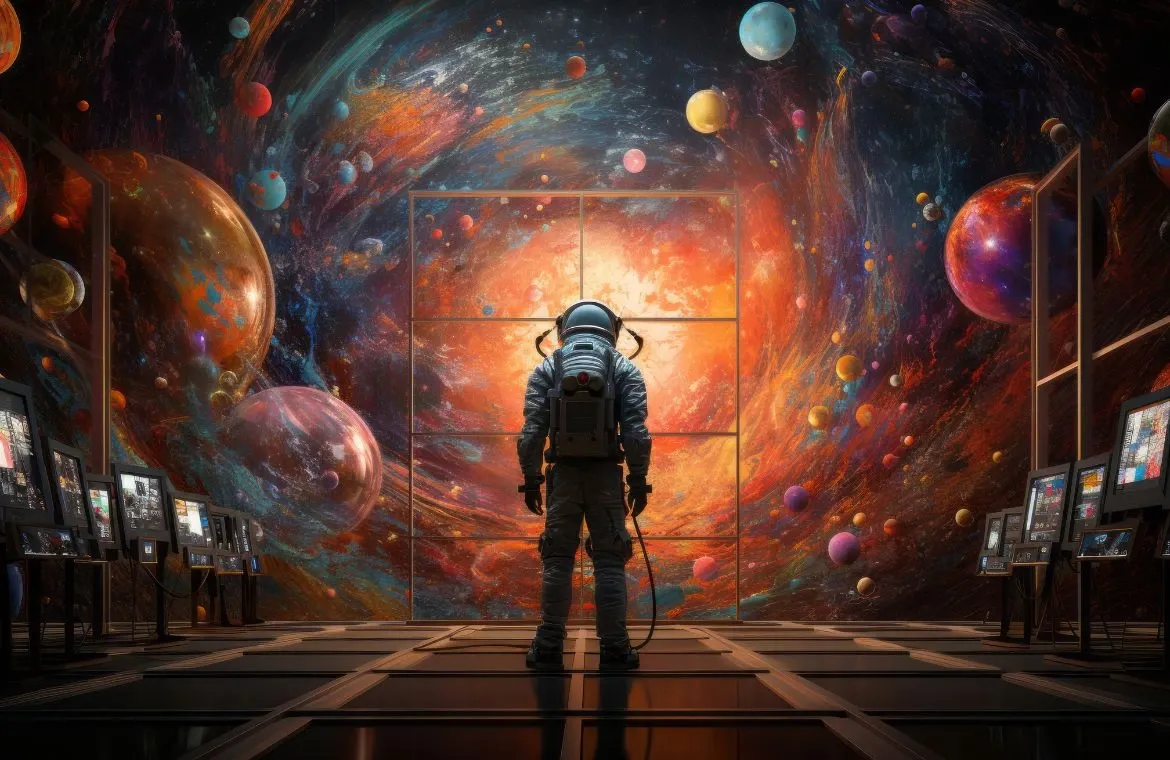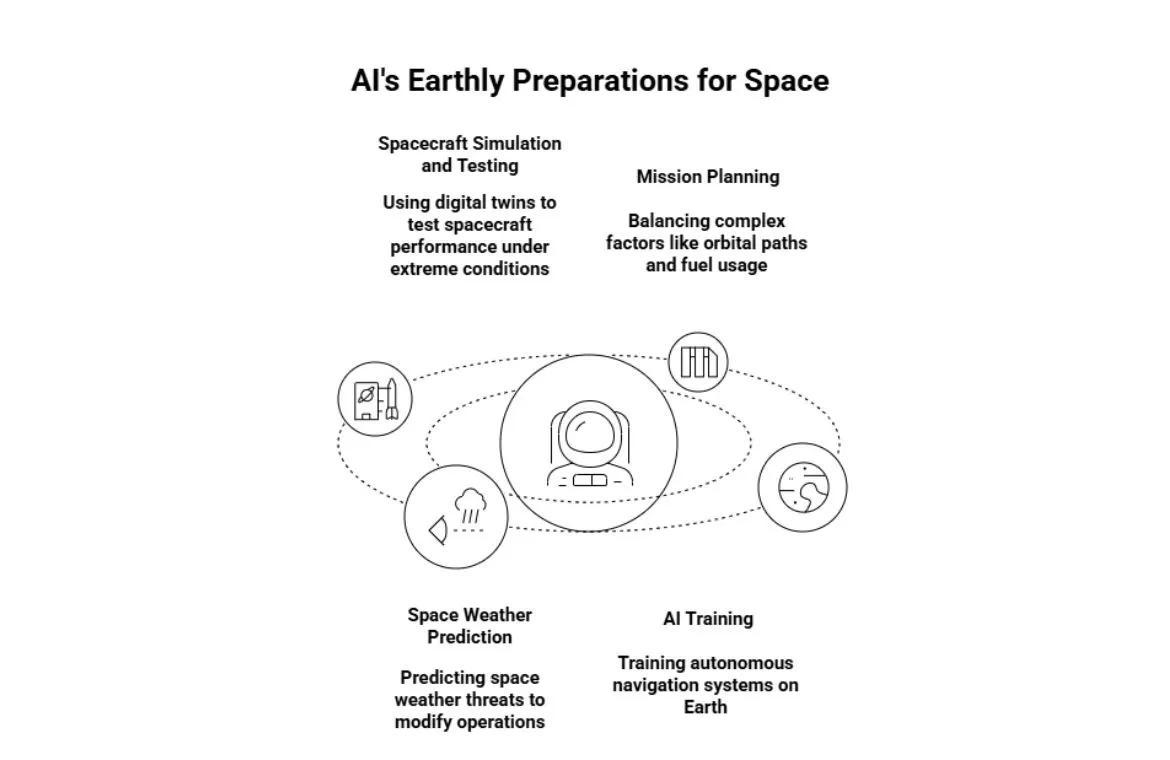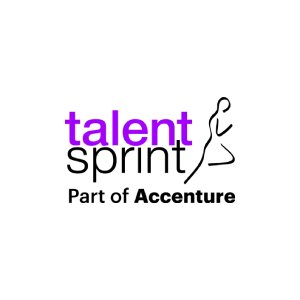AI in Space Exploration: From Earth's Labs to Mars Discoveries

Space instruments now generate terabytes of data each day - way more than scientists can process by hand. AI has reshaped our understanding of space exploration and opened up new paths to find breakthroughs.
As we stand on the edge of a new space race, one powered not just by rockets, but by real-time data, self-learning systems, and machine reasoning, it's clear: artificial intelligence in space is not just enhancing exploration, it's redefining it.
This article demonstrates how AI is reshaping space exploration, transitioning from Earth-based projects to discoveries on Mars. Learning about these technologies is vital to anyone who wants to be part of humanity's greatest quest.
What is AI and Space Exploration?
Artificial intelligence (AI) and space exploration have become increasingly intertwined as humanity ventures deeper into the cosmos. Anyone wanting to contribute to this expanding frontier must understand this relationship.
Defining Artificial Intelligence in simple terms
AI enables computers or robots to replicate human intelligence. These systems do more than follow preset instructions - they analyse data, make decisions, and improve over time. Machine learning creates modern AI by training simple algorithms with huge datasets to develop more complex capabilities.
Why AI and Space are a Natural Fit?
Space creates unique challenges that AI can handle effectively. The vast distances create communication delays, making real-time control from Earth impractical. Extreme environments require systems that can make decisions independently.
AI proves excellent at analysing huge amounts of space mission data. It spots patterns humans might miss and helps spacecraft move independently. The technology reduces human workload by automating routine tasks. It also optimises mission planning and improves spacecraft health monitoring.
From Earth’s Labs: How AI Prepares for Space

AI systems need extensive preparation in Earth-based laboratories before their space journey. These ground testing facilities provide vital proving grounds that help refine algorithms and systems to handle the unique demands of space operations.
Also Read: Careers in the Space Industry
AI in spacecraft simulation and testing
Modern AI algorithms drive virtual testing environments that mirror harsh space conditions. Engineers use these digital twins to test spacecraft performance under extreme temperatures, radiation exposure, and mechanical stress without building physical prototypes. Teams can spot potential failures and fine-tune systems before launch, which reduces risks and saves millions in development costs.
Designing efficient missions using AI models
AI has transformed mission planning completely. Smart algorithms now balance complex factors, such as orbital paths, fuel usage, and research goals, simultaneously. AI systems also predict space weather threats more accurately than traditional methods, which gives planners sufficient time to modify operations.
Training AI with Earth-based datasets
Earth serves as the perfect training environment for space-bound AI. Autonomous navigation systems also undergo training on Earth's obstacle courses before tackling the rough terrain of other worlds.
This ground preparation matters because algorithms must make solid decisions before deployment, where distance makes human control difficult.
Earth-based preparation remains essential to improve AI's reliability for space exploration.
AI in Action: Current Use Cases in Space
AI changes space missions by enabling quick exploration beyond Earth. Space operations now show how artificial intelligence delivers real benefits rather than just theoretical advantages.
Also Read: Space Technology Used in Everyday Life
- Autonomous rovers
In the Chandrayaan-3 mission , ISRO’s Pragyan rover used AI-powered algorithms for autonomous navigation and terrain mapping on the Moon’s surface.
- AI in satellite operations and Earth observation
ISRO’s Cartosat series of Earth observation satellites use AI for image enhancement, cloud detection, and change detection in land use and urban expansion.
- AI in analysing astronomical data
Indian institutions like the Aryabhatta Research Institute of Observational Sciences (ARIES) are using AI models to analyse data from telescopes to detect exoplanets and study galaxy evolution.
What AI Brings to Space: Benefits and Risks
AI's integration into space missions tells two stories - one of amazing benefits and another of challenges that need careful handling as we push deeper into space.
1. Making missions safer and more efficient
AI systems make mission outcomes better through immediate analysis and independent decision-making.The Advanced rovers can navigate Mars on its own without waiting for instructions from Earth. This self-reliance becomes crucial when communication delays make Earth-based control impossible. AI prediction systems also monitor the health of spacecraft. They spot potential failures early and suggest fixes before problems occur.
2. Cutting down human work and mistakes
AI's biggest advantage in space exploration lies in handling complex but routine tasks.. AI-powered robots now handle critical tasks such as repairing satellites, maintaining spacecraft, and exploring planets - jobs that would put human lives at risk.
3. The downside of trusting autonomous systems too much
In spite of that, relying on AI systems brings clear risks. AI might mix up threats, like seeing a commercial satellite as hostile, which could lead to unwanted conflicts in space. These systems run on limited computing power in tough environments where radiation can harm electronics.
4. Safety and ethics of AI in space
Beyond technical issues, using AI brings up serious questions about security and ethics. Space agencies must protect AI-driven systems with strong encryption to prevent unauthorised access. They need systems that can spot unusual patterns that might signal security threats.
Looking Ahead: AI’s Role in Future Discoveries
Space exploration's future depends on artificial intelligence technologies that will help us make discoveries we can't even imagine today. As we venture further into our solar system, AI systems will become our crucial partners in humanity's greatest adventure.
AI in detecting exoplanets and alien signals
AI algorithms are changing how astronomers look for habitable worlds. Advanced neural networks process huge amounts of data from space telescopes. They can spot tiny light changes that show when planets pass in front of stars with amazing accuracy.
AI for long-duration missions to Mars and beyond
Missions to distant planets need systems that can work with minimal guidance from Earth. Future Mars missions will use AI to make split-second decisions during landing. The AI will adapt to Mars's environment without waiting for instructions from Earth.
Collaborative AI-human systems in space habitats
Space habitats of the future will feature AI systems working hand in hand with human crews. These smart assistants will keep life support running, spot equipment problems before they happen, and manage resources efficiently.
Conclusion
AI has changed how we explore space and turned impossible dreams into reality. Smart rovers now roam Mars while AI systems crunch astronomical data. These technologies help humans reach far beyond Earth.
The benefits are clear, but some hurdles still exist. Space agencies need to think about security weak spots, ethical issues, and how much we depend on these systems.
So, Space exploration needs engineers and tech experts who understand both AI and space technology. Your skills in machine learning, computer vision, robotics, or data science could shape humanity's greatest journey. The space industry needs people who can build reliable AI systems that work in the harshest places we know.
A program like the Advanced certification programme in Space Technologies can be that essential launchpad as it can provide professionals with not just knowledge, but also the mindset to innovate, automate, and collaborate in the high-stakes world of aerospace and planetary science.
Because in the vast silence of space, it’s the intelligent systems we build, and the vision we carry, that will echo the loudest.
Frequently Asked Questions
Q1. How is AI currently being used in space exploration?
AI is being used in various ways, including autonomous navigation for Mars rovers, data processing on Earth-observing satellites, and as AI companions like CIMON on the International Space Station. It's also crucial in analysing vast amounts of astronomical data from telescopes and observatories.
Q2. What are the main benefits of using AI in space missions?
AI enhances mission efficiency and safety by enabling real-time data analysis and autonomous decision-making. It reduces human workload and error by handling complex tasks, and it's particularly valuable in situations where communication delays make real-time control from Earth impractical.
Q3. How is AI prepared for space missions while still on Earth?
AI systems undergo rigorous preparation in Earth-based laboratories. This includes spacecraft simulation and testing, designing efficient missions using AI models, and training AI with Earth-based datasets that simulate space environments and challenges.

TalentSprint
TalentSprint is a leading deep-tech education company. It partners with esteemed academic institutions and global corporations to offer advanced learning programs in deep-tech, management, and emerging technologies. Known for its high-impact programs co-created with think tanks and experts, TalentSprint blends academic expertise with practical industry experience.



